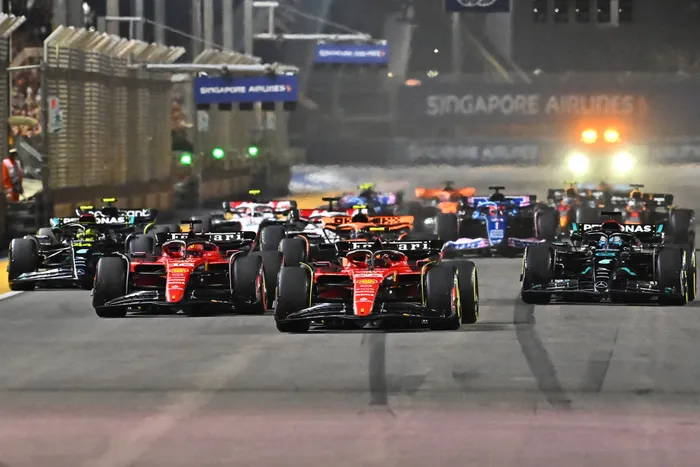Pitlane speed changes could shake up Singapore Grand Prix strategies
FORMULA 1

Ferrari's Spanish driver Carlos Sainz Jr drives in front of the field during the start of the Singapore Formula One Grand Prix night race The file picure of the start of the Singapore Formula One Grand Prix night race at the Marina Bay Street Circuit in Singapore. | AFP
Image: AFP
The 2025 Singapore Grand Prix will see a significant adjustment that could alter the complexion of Sunday’s race, with the FIA confirming an increase to the pitlane speed limit at Marina Bay.
After years of operating at 60 km/h, drivers will now be allowed to run through the pitlane at 80 km/h, provided the safety trial during Friday practice sessions proves successful.
The change may seem minor, but in a race where track position and pit stop timing can make or break a strategy, the implications are potentially game-changing. At roughly 400 metres long, the Marina Bay pitlane has always been one of the most punishing in Formula 1.
Under the old 60 km/h restriction, the time loss for a stop was substantial, making teams reluctant to commit to two-stop strategies. Instead, the default approach was a cautious one-stop race, with overtaking on the tight, twisty streets proving notoriously difficult.
By raising the speed limit, the FIA hopes to ease that penalty. Early calculations suggest a gain of around four to six seconds in total pitlane time, reducing the overall cost of pitting.
That might not sound like much, but in a sport often decided by tenths of a second, those margins could tempt teams into taking more aggressive approaches, especially if tyre wear proves higher than expected or if the safety car makes its traditional appearance around Singapore.
The move follows modest modifications to the pitlane itself, including a slight widening and resurfacing that allowed the FIA to confidently raise speeds without compromising safety. Officials will closely monitor the trial run on Friday, with the option to revert to 60 km/h if any concerns emerge.
Strategically, the change opens the door for variety. Teams may now consider a two-stop plan, knowing they will not be punished as heavily by the clock.
That, in turn, could encourage drivers to push harder during stints, producing closer battles on track rather than the conservation runs often seen at Singapore.
Still, Singapore’s reputation as one of the most difficult circuits for overtaking remains. Track position will continue to carry weight, and even with a reduced pit time, the challenge of gaining ground in traffic is real.
Yet the adjustment adds a new layer of intrigue to a race already billed as one of the toughest on the calendar, ensuring that strategy could play as big a role as outright speed this weekend.
Related Topics: